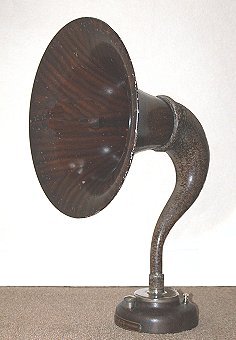|
The largest and more expensive model was
the 24" high 'Standard Loudspeaker' with either a metal or
wooden horn. The metal horn came in either a matt black or
grained wood finish and the wooden horn was available with oak
or mahogany flares. The matt black metal horn version sold for
£4, the wood grained metal horn sold for £4.5s.0d. and the
wooden models were £4.15s.0d. The loudspeakers were also built
into the A.J.S. 'Pedestal' receivers and the 'Consol' receiver.
The sound quality is poor when compared
with a modern loudspeaker due to lack of sensitivity, a limited
frequency range and lack of dynamic range due to their inability
to handle large signals without distortion. The sound quality
from the models with a wooden horn is supposedly better,
probably more mellow due to the acoustic properties of the wood.
|

A 'Standard' model with a metal horn. |